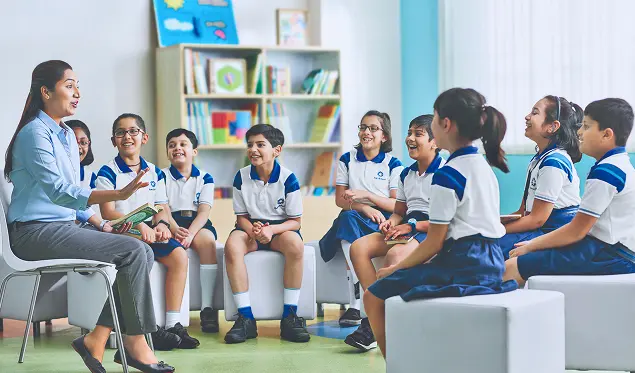Language is an incredibly potent instrument that shapes our communication, comprehension, and overall growth. However, youngsters may encounter language barriers in their early school years, hindering their ability to learn effectively. It is crucial to overcome language barriers in children to establish an inclusive and productive learning environment. Below, we will discuss the concept of language barriers, provide common examples, and offer practical strategies to overcome them.
Also read: What are the 5 Typеs of Language Skills?
Language Barriers in Kids
A language barrier in kids refers to communication and comprehension problems resulting from disparities in language competency. This difficulty may impact a child’s social and academic development, among other aspects of their growth.
- Examples of Language Barriers
- Limited Vocabulary
- Grammar Difficulties
- Cultural Nuances
Language barriers can prevent communication in various contexts, from school to daily interactions. Let’s explore some common examples where these barriers hinder effective understanding:
Children with limited vocabulary may find it challenging to express their thoughts and feelings. Educators can address this and other language barrier issues by introducing exercises that broaden students’ vocabulary, tailored to meet their individual linguistic needs.
Misunderstandings can result from variations in grammatical constructions. Teachers can use interactive grammar assignments to help students understand grammar principles through real-world examples of language barriers.
Overcoming linguistic barriers requires a high degree of cultural sensitivity. By incorporating diverse cultural viewpoints into the curriculum, educators can create a welcoming environment where linguistic nuances are appreciated.
Also read: 7 barriers of communication
Practical Strategies for Overcoming Language Barriers
To enhance communication and advance comprehension in various contexts, learn how to overcome language hurdles with practical strategies:
- Immersion Language Learning Programs
- Peer-Assisted Learning
- Cultural Celebrations
- Linguistic Support Teams
- Language-Integrated Play
- Multilingual Storytime Sessions
- Cultural Exchange Programs
- Language Buddy Systems
- Language-Inclusive Curriculum
- Community Language Workshops
Engage children in activities conducted in multiple languages, fostering language acquisition and immersive learning experiences. These programs offer children a rich linguistic environment where they can explore and interact with various languages through language-specific classes, cultural activities, and themed events.
Encouraging kids from different language backgrounds to work together on group projects promotes peer assistance and dialogue, improving language skills. Collaborative project work helps children learn empathy, cultural sensitivity, and cooperation while benefiting from each other’s language abilities.
Organize events that celebrate linguistic diversity to expose kids to various languages and develop their linguistic awareness and comprehension. Multicultural festivals and language-themed days offer engaging opportunities for children to learn about different cultures and languages in an entertaining and participatory setting.
Form teams of educators, counselors, and language experts to offer specialized assistance to kids struggling with language barriers in school. These teams can provide individual language training, counseling services, and resources for parents to support their child’s language development at home.
Incorporate language into play activities like role-playing, storytelling, and interactive games to make language development enjoyable and engaging. Play-based learning encourages language acquisition through active engagement and discovery, allowing kids to experiment with language in a fun and relaxed setting.
Organize storytelling sessions featuring stories in different languages, allowing children to explore various linguistic narratives and broaden their language skills. Storytime sessions can include books, songs, and rhymes in multiple languages, exposing children to diverse cultural perspectives and linguistic styles.
Create language exchange programs with schools from different linguistic backgrounds so that children can interact and learn from peers who speak different languages. These initiatives can foster cross-cultural communication and friendships through joint projects, pen pal programs, and virtual or in-person interactions.
Implement buddy systems that pair kids with classmates who speak different languages to encourage mutual support and language learning. Buddies can participate in language-focused activities together, like conversation practice, games, and cultural exchanges, providing opportunities for peer mentoring and cooperation.
Encourage language acquisition and the use of several languages in academic settings by integrating language learning into the curriculum across all subject areas. Children are better able to understand the value of language proficiency in various learning contexts and daily activities when language learning is incorporated into courses like social studies, science, and math.
Organize community-based workshops to give kids and their families access to language instruction and create a nurturing environment for language acquisition outside of school. These workshops can include family-friendly events, cultural activities, and language lessons, enabling kids and their families to embrace and enjoy the diversity of languages spoken in their neighborhood.
Also read: The Importance of Language Arts for Children’s Development
Enhancing Language Skills: A Collaborative Effort
Empower yourself with practical techniques to improve language proficiency and communication abilities.
- Language Ambassadors
- Home-Language Integration
Designate language ambassadors within classrooms. Students who excel in a particular language can assist their peers in understanding linguistic barriers. This approach promotes peer learning, mutual support, and helps reduce language barrier issues.
Incorporate home languages into the learning process. An inclusive school atmosphere benefits from acknowledging and embracing the linguistic diversity in each child’s family.
Also read: How Children Learn and Teach Language
Addressing Language Barriers in Education
- Understanding the Impact
- Impact on Academic Progress
- Developing Early Linguistic Resilience
Language difficulties in the classroom can significantly affect a child’s academic journey and overall schooling experience. These barriers involve various factors, including linguistic diversity, vocabulary disparities, and potential communication challenges. Recognizing the complexity of these barriers is a critical first step in implementing practical strategies that promote inclusive learning environments.
Youngsters with language difficulties may struggle to follow lessons, engage in classroom activities, and have productive conversations with teachers and peers. These difficulties can obstruct their ability to learn critical skills and advance academically. Educators must explore the unique characteristics of language difficulties and design appropriate interventions to overcome language barriers in education.
Developing early linguistic resilience calls for a comprehensive strategy that incorporates cooperation, diverse tactics, cultural sensitivity, and real-world examples. Teachers and parents can enable children to navigate linguistic diversity and develop inclusivity and understanding for a rich language journey ahead by identifying language difficulties and adopting tailored interventions.
At EuroSchool, our commitment is to provide students with a dynamic education that transcends traditional boundaries. We honor each child’s unique learning styles, fostering a thorough and fulfilling educational experience. As innovators, EuroSchool employs personalized strategies to complement individual abilities, setting students on a path of achievement, development, and exploration. Our sincere love of learning extends beyond the classroom, preparing students for a lifelong journey of intellectual curiosity and discovery.









